E.G. Lewis's Blog, page 7
March 28, 2012
RELICS OF CHRIST'S PASSION & DEATH: VERONICA'S VEIL
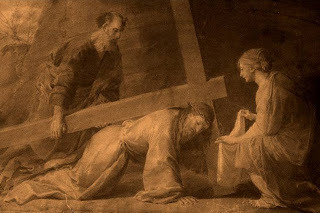 An Ancient Painting of Veronica Wiping the Face of Jesus
An Ancient Painting of Veronica Wiping the Face of JesusHello My Friend and Welcome.
As our Lenten-Easter Study draws to a close, we turn to three relics of Jesus' passion and death. Some folks have problems with the concept of relics. Even if you happen to be one of those people, I encourage you to read along anyway. You may find your view of relics changing.
A LINK TO THE PASTHave you ever known someone who possessed a picture of…say their great-great grandfather? Bringing out a box, they carefully remove an old tintype. Then, with care and extreme pride, they offer it to you, saying, "This is a photo of my great, great grandfather." You stare down at the aged photo of a young man with a mustache. Standing erect, in pinstripe suit and starched collar, he looks rather solemn. Standing beside him is an equally somber woman in a long dress holding an infant. "It was taken the day he enlisted to fight in the Civil War," you're told. So what, it's only a photograph, right? But to them it's much more. It's a memory, a link to their history…a way to know someone who died many years before they were born.
Like all civilizations, we revere our past and its heroes. These people represent our highest ideals and greatest achievements. We write books about them, build monuments to them, turn their homes into museums, and treasure even the small everyday items they used. It's not unusual to hear some speak of them with deep admiration, even reverence. Why should we expect the Early Christians to have been any different? They held the saints and martyrs in high esteem, but they do not worship them. The same applies to relics. They are not worshipped, but they are certainly venerated by many people.
VERONICA AND HER VEILAt one time or another, most of us have heard the story of Veronica and her veil. According to the legend, Veronica was a pious woman from Jerusalem who encountered Christ on his way to Calvary. Deeply moved by his suffering and seeing His face covered with sweat and blood, she wiped it with her veil. She later found his portrait imprinted on the cloth.
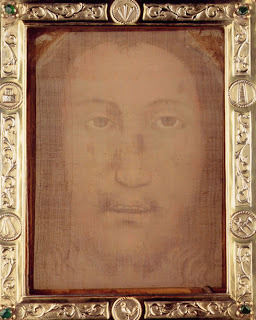 The Image on the Veil Her veil still exists today. It is a relic of our Lord's passion. The nearly transparent cloth measures about 6.5 by 9.5 inches and bears the dark red features of a bearded man with long hair and open eyes. It is the face of a young man who has suffered greatly. He looks tired and the marks of blows are clear…bruises on his forehead, clotted blood on his nose, one pupil slightly dilated. Yet, in spite of the evident signs of suffering and pain, the look is of a serene man enduring his suffering with patience.
The Image on the Veil Her veil still exists today. It is a relic of our Lord's passion. The nearly transparent cloth measures about 6.5 by 9.5 inches and bears the dark red features of a bearded man with long hair and open eyes. It is the face of a young man who has suffered greatly. He looks tired and the marks of blows are clear…bruises on his forehead, clotted blood on his nose, one pupil slightly dilated. Yet, in spite of the evident signs of suffering and pain, the look is of a serene man enduring his suffering with patience. It's a story that's been told and retold. Zefferelli included it in his movie, Jesus of Nazareth, and I included it in my book, Witness. Yet the scene appears nowhere in the Bible. In fact, it comes from an apocryphal book called The Acts of Pilate. Critics say this is proof the story of Veronica's Veil is nothing but pious fiction, legends developed over the ages. They also claim her name, Veronica, is a combination of the words true vera (Latin) and image eikon (Greek).
DEALING WITH THE QUESTION OF THE NAMELet's put the name thing to rest first. The idea of a manufactured name can be traced back to the Otia Imperialia of Gervase of Tilbury in Essex, England (d. 1211) Gervase's work was translated and distributed throughout Europe. The idea took hold and has been passed down ever since. Like the mistaken belief that Christmas was placed on December 25th to coincide with the pagan celebration of the solstice (HERE) or that Easter began as the feast of the goddess Eostre, (HERE) these myths are easily refuted with a few facts.
We all know that names move from one culture to another, changing and adapting as they go. Sometimes they're easily recognized, as in the case of Edward and Eduardo. Other times, the connection is not so obvious. For instance, in Russian John becomes Ivan, in Scottish Ian, and in German Yohan. The same sort of thing existed in Biblical times. People frequently had two names, one Greek and one Aramaic. The apostle Simon was called Cephas in Aramaic and Petros in Greek…both mean building stone or rock. The Greek form of Berenice is Berenike which, interestingly enough, in Latin becomes…Veronica.
WHAT ABOUT THE VEIL ITSELF?Veronica's Veil has a tradition and documented history far exceeding the Shroud of Turin. For hundreds of years it was enshrined in St. Peter's Basilica. Then when the part of the Basilica containing the relic was scheduled for remodeling, it disappeared. It eventually resurfaced in a Capuchin church in the town of Manoppello, in Italy's Abruzzi region. Farmers and fishermen there have revered this veil for centuries as The Holy Face (Il Volto Santo). Before the veil came to the Vatican, it was in Constantinople, and before that it was in the Middle East. A Syrian text from Kamulia in Cappadocia from the Sixth Century tells us that the image was on a material "drawn out of the water" and "not painted by human hand."
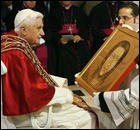 Pope Benedict XVI Examing Veronica's VeilWhen this image first arrived in Rome, curious pilgrims were drawn to it like metal to a magnet. In the Middle Ages, pilgrims who went to Jerusalem often decorated themselves with branches of palm trees on their return. Even today, a sign of the pilgrims on the route to Santiago de Compostela is a shell. Likewise, pilgrims to Rome stitched miniature images of Christ onto their capes on their way home: little pictures of the "Sancta Veronica Ierosolymitana" — the holy Veronica of Jerusalem.
Pope Benedict XVI Examing Veronica's VeilWhen this image first arrived in Rome, curious pilgrims were drawn to it like metal to a magnet. In the Middle Ages, pilgrims who went to Jerusalem often decorated themselves with branches of palm trees on their return. Even today, a sign of the pilgrims on the route to Santiago de Compostela is a shell. Likewise, pilgrims to Rome stitched miniature images of Christ onto their capes on their way home: little pictures of the "Sancta Veronica Ierosolymitana" — the holy Veronica of Jerusalem. The veil itself is transparent, much like a silk stocking. The image is less a painting and more like a large photographic slide. The delicate cloth is a golden, honey color, which is how Gertrud of Helfta described the face of Christ in the 13th century. Held up to the light, the veil becomes transparent and shows the countenance in three-dimensional, almost holographic clarity on both sides.
Given its consistency, the veil would seem to be made of nylon — a fabric invented by DuPont in 1935. What is it then…cotton, wool, linen? All are much too thick to allow this immaterial transparency, even silk does not permit it.
ENTER BYSSUS, THE CLOTH DRAWN FROM WATERSo what is the veil made of? Byssus. And what, you ask, is that? The word byssus originated with Biblical Hebrew būts or butz בוץ meaning "a fiber or fabric distinguished by its fineness." The word is used to describe the fine white linen used for the priestly vestments and carpets in the Holy of Holies.
Translated into Latin, it became byssus and referred to fine sea silk. A deep golden bronze color, the cloth is spun from tufts of the long, tough filaments that certain bi-valve mollusks, principally the pinna noblilis or pen shell, use to attach themselves to rocks. It was the most expensive fabric of the ancient world and has been found in the tombs of Egyptian pharaohs. The Greek historian, Herodotus, who visited Egypt in 500 BC, described it as "a gauzelike cloth of a golden hue…made from the fine threads of many mollusks. It is finer than a hair…"
 Fine Threads of Byssus Chiara Vigo, who lives on a small island off the coast of Sardinia, is one of the world's last weavers of byssus. She examined the cloth of Veronica's veil and confirmed that it is indeed spun from byssus. All proportions of the image conform to life-size measurements of the human face and there is no trace of color or paint anywhere on the cloth. Sister Blandina Paschalis Schlomer, a German Trappist nun, pharmacist and icon painter, made painstaking comparisons of the image on the Manoppello cloth and the face of the man depicted on the Shroud of Turin. Every detail of both faces is congruent. They are the same size, the same shape, with the same wounds…in other words, the same man.
Fine Threads of Byssus Chiara Vigo, who lives on a small island off the coast of Sardinia, is one of the world's last weavers of byssus. She examined the cloth of Veronica's veil and confirmed that it is indeed spun from byssus. All proportions of the image conform to life-size measurements of the human face and there is no trace of color or paint anywhere on the cloth. Sister Blandina Paschalis Schlomer, a German Trappist nun, pharmacist and icon painter, made painstaking comparisons of the image on the Manoppello cloth and the face of the man depicted on the Shroud of Turin. Every detail of both faces is congruent. They are the same size, the same shape, with the same wounds…in other words, the same man. So there we have the facts regarding Veronica's Veil. None of this convinces some skeptics. Nothing ever will. In the final analysis it's more about faith than science anyway, isn't it?
The next time we'll examine the Sudarium, or cloth that covered the Lord's face and head.
Until then, we wish you Peace and Blessings
If you reached this post via a link, click the HOME tab above to see other recent posts and visit our archives.
Published on March 28, 2012 01:00
March 26, 2012
THE MEN WHO TRIED JESUS: PONTIUS PILATE
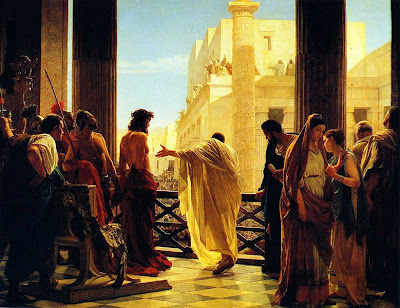 The Famous Painting by Antonio Ciseri Ecce Homo - Behold the Man
The Famous Painting by Antonio Ciseri Ecce Homo - Behold the ManHello My Friend and Welcome.
Our series of posts on The Men Who Tried Jesus now turns to the fourth, and arguably most famous, judge of Jesus, Roman Prefect, Pontius Pilate. He is immortalized in the phrase from both the Apostles and Nicene Creeds, "…suffered under Pontius Pilate, was crucified, died and was buried."
There are several points about Pilate that require clarification. First, as the fifth Prefect to Judea, he is sometimes referred to as the Roman Procurator. Pilate was not a Procurator; his title was Prefect. Cuspius Fadus was the first Procurator of Judea in AD 44 …eight years and two Prefects after Pilate. This confusion derives from Tacitus who, in Annals, 15.44, called him by that title.
WRITTEN IN STONE Some critics of Christianity have claimed Pilate is an imaginary figure created by the Gospel writers. Though limited, there are historic records of Pontius Pilate outside of the Bible. He is referred to by Josephus, Philo, and Church historian Eusebius as well as other Church Fathers and, as mentioned above, by Tacitus. This nonsense was finally put to rest in 1961 when archaeologists discovered a block of limestone that had once been the cornerstone of a Roman theatre at Caesarea Maritima, the capital of the Province of Judaea. One could say the proof of Pilate's existence is now carved in stone. Reconstructing the missing portions of the inscription, it becomes: S TIBERIEVM (Dedicated to the Emperor Tiberius) by PONTIVS PILATVS (Pontius Pilate) PRAECTVS IVDAEAE (Prefect of Judaea).
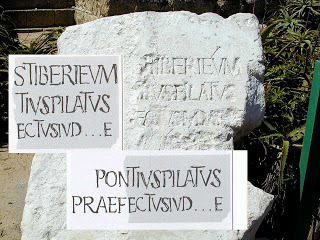 Pilate Cornerstone In Caesarea MaritimaA name in ancient Rome consisted of three parts, a praenomen, or given name, a nomen, or name of the gens or clan, and a cognomen, which is the family line within the gens. History never tells us what his praenomen was. The cognomen Pilatus is derived from the word pilum and means one skilled with the javelin. This should not be taken to mean that Pontius Pilate was a soldier, any more than your neighbor Mr. Smith earns his living as a blacksmith, or the father of your friend Mr. Johnson is named John. The family name, Pontius, signifies he was from the tribe of the Pontii. It is an ancient Samnite name. Tradition places Pilate's birthplace in the small village of Bisenti, in Samnite territory…today's Abruzzo region of Central Italy.
Pilate Cornerstone In Caesarea MaritimaA name in ancient Rome consisted of three parts, a praenomen, or given name, a nomen, or name of the gens or clan, and a cognomen, which is the family line within the gens. History never tells us what his praenomen was. The cognomen Pilatus is derived from the word pilum and means one skilled with the javelin. This should not be taken to mean that Pontius Pilate was a soldier, any more than your neighbor Mr. Smith earns his living as a blacksmith, or the father of your friend Mr. Johnson is named John. The family name, Pontius, signifies he was from the tribe of the Pontii. It is an ancient Samnite name. Tradition places Pilate's birthplace in the small village of Bisenti, in Samnite territory…today's Abruzzo region of Central Italy. THE LADY CLAUDIA PROCULAPilate's wife, Claudia Procula, has an interesting history of her own. She is said to have been the illegitimate daughter of Julia, Octavian's only biological child. Julia married Marcus Claudius Marcellus (the son of Octavian's sister Octavia) at the age of fourteen. He died two years later. She led a promiscuous life and had many lovers while married to Marcus Vipsanius Agrippa. When Agrippa died, she married Tiberius who would later become Emperor. Her father eventually gave Tiberius permission to divorce her due to her scandalous behavior and then banished her from Rome. She was pregnant when she arrived in Gaul and no one knows who fathered the child. Julia died shortly after giving birth to her daughter Claudia. This makes Claudia Procula the granddaughter of Octavian, later known as Caesar Augustus. Tiberius eventually adopted her as his daughter. She grew up in the Roman Province of Narbonensis in what is now known as the French Riviera. Her connection to the ruling elite may very well have been the reason Pilate got his position in Judea.
Claudia Procula is best remembered for the dream she had. "Besides, while he (Pontius Pilate) was sitting on the judgment seat, his wife sent word to him, 'Have nothing to do with that righteous man, for I have suffered much over him today in a dream.'" Matthew 27:19. Many people in the ancient Church considered her to be a secret follower of Jesus. The Eastern Orthodox Church lists her among their saints and celebrates her feast day on October 27th.
PILATE'S ACTIONS DURING THE TRIALThere are varying interpretations to Pilate's actions in the trial of Jesus. Properly read, it is easy to find evidence he was doing everything possible to avoid convicting Jesus. He told the Chief Priests who'd brought Jesus to him, "I find no crime in this man." Luke 24:4. Then, upon learning Jesus was a Galilean, he passed him off to Herod in the hopes of avoiding responsibility.
When Herod sent Jesus back, Pilate again insisted, "You brought me this man as one who was perverting the people; and after examining him before you, behold, I did not find this man guilty of any of your charges against him; neither did Herod, for he sent him back to us. Behold, nothing deserving death has been done by him; I will therefore chastise him and release him." Luke 23:14-17
When they continued screaming for his death, Pilate played his last bargaining chip by bringing out Barabbas. When this ploy backfired, he said, "'Why, what evil has he done?'" Matthew 27:23. Then in a symbol that has resonated through the ages, "he took water and washed his hands before the crowd, saying, 'I am innocent of this man's blood…'" Matthew 27:24.
Clearly, Annas, Caiaphas and their cronies outfoxed Pilate. Rather than do what he knew to be right, he acquiesced when they threatened to accuse him of being disloyal to Caesar. When a person was crucified, a titulus —a plaque which listed the prisoner's name and offense — was nailed to the palus, the upright stake of the cross, for everyone to see when they reached the place of execution. Many crucifixes have the image of a scroll at the top with the letters INRI on it. These letters stand for Iesus Nazarenus, Rex Iudaeorum Latin for Jesus of Nazareth, King of the Jews.
Pilate made no mistake when he wrote those words on the <em>titulus</em>. Whatever slight comfort it may have provided, Pilate managed to get in the last word in his confrontation with Annas and Caiaphas. The Priests complained in outrage and he responded, "What I have written I have written." John 19:22, thus ending one of the worst days in the life of Pontius Pilate.
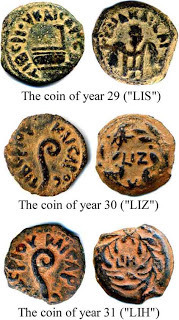 Coins Minted Under Pontius Pilate
Coins Minted Under Pontius PilatePILATE REMOVED FROM OFFICE
Pilate remained in office for several years after Jesus was executed. He was removed from office in AD 36 by the Syrian governor, Vitellius, for ordering troops into Samaria to attack a peaceful assembly of Samaritans. Pilate left Judea heading for Rome and an official review of his conduct before Caesar. However, by the time he arrived in Rome Tiberius was dead and Caligula had taken his place. What happened next, no one knows.
Some old traditions say Pilate committed suicide in Rome. The Christian Historian, Eusebius, tells the story and attributes it to the former governor's remorse for the execution of Jesus. One must temper these reports of suicide with the understanding that to the Romans suicide was considered an honorable death. In fact, if someone displeased the Emperor he could order them to kill themselves and, in most cases, they complied. Other sources say he was exiled to Gaul and committed suicide in Vienne and his body was thrown into the Rhône River. There is even a monument at Vienne, called Pilate's tomb. In Switzerland, near Lucerne, there is a Mount Pilatus. An old tradition states Pilate was banished to the mountain as punishment.
Pilate appears in apocryphal writings such as The Gospel of Peter, The Acts of Pilate, and The Acts of Peter and Paul. They address the question of what happened to Pilate and, in some cases, also depict him converting to the Christian faith. In addition to Saint Claudia, the Coptic Church also lists Pontius Pilate as a saint. How much of this is a pious attempt to show that no one is beyond redemption and how much is fact, is anyone's guess.
Part of what makes Pilate such an interesting historical character is the dilemma he faced on that first Good Friday. At that moment he becomes not a Roman official, but everyman. Like Adam, and everyone after him, Pilate finds himself at a crossroads of good and evil. He apparently knows what should be done, what is right, or in his words, what is true. But the world beckons him. To do what he knows is right he must risk all that he has…his power and position, his lavish lifestyle, future opportunities for advancement and retirement with honors. Pilate chose what appeared to be the safe path. But, as Jesus said, whoever wants to save his life will lose it and lose it he did.
THE FINAL IRONYBefore we leave Pilate there is one final irony to address. Matthew tells us the Priests went to him and asked for guards at the grave to prevent his disciple from stealing the body. Pilate authorizes it. Yet on Easter morning when the women arrive, the stone is rolled aside, the body is gone, and the soldiers are nowhere to be seen.
Later the Priests tell the soldiers to say they fell asleep and the disciples stole the body. Sleeping on guard duty was a capital offense in the Roman army. The priests promised to smooth things over if word reached Pilate. Could they smooth things over? It seems very unlikely. So why don't we hear anything about the fate of those soldiers? Shouldn't at least one of the four Gospel writers have addressed the issue? Or was there an issue? Could it be that Pilate did hear about it and he was the one that swept it under the rug? Why would he do such a thing?
Next time we'll visit the fourth, and final, man who judged Jesus…Herod Antipas.
Until then, we wish you Peace and Blessings.
If you reached this post via a link, click the HOME tab above to see other recent posts and visit our archives.
Published on March 26, 2012 01:00
March 23, 2012
THE MEN WHO TRIED JESUS: HEROD ANTIPAS
 Frank Thring as Herod Antipas in King of Kings
Frank Thring as Herod Antipas in King of KingsHello My Friend and Welcome.
Today we visit the third participant in the trial of Jesus of Nazareth, Herod Antipas.
Herod Antipas' true name was Herod Antipater. Antipas is the familiar form of Antipater, which by the way, was the name of Herod the Great's father, grandfather, and oldest son. Antipas mother' was Malthace, Herod's sixth wife. He had one full brother, Archelaus, who was named ethnarch (national leader) of Judea, Idumea and Samaria following their father's death. At the same time, Augustus named both Antipas and his half-brother Phillip tetrarchs (rulers of a fourth). Antipas was about 17 years old when he left Rome for Galilee to take control of a portion of his deceased father's kingdom. Even more surprising is the fact that in Herod's previous will, over-written just a short time before his death, Herod Antipas was named as his sole heir.
COMPLICATED RELATIONSHIPSAntipas, as we'll call him to differentiate him from his father, married twice. His first wife, Phasaelis, was the daughter of King Aretas IV of Nabatea. Phasaelis might have been a relative —a cousin perhaps— although the historic record neither denies nor confirms it. The marriage may very well have a political one designed to forge an alliance with King Aretas. In addition to Galilee, Antipas' tetrarchy included Perea, which shared a border with Nabatea.
Here's some justification for the assumption she was family. First, Herod the Great's mother, Cypros, was a member of the Nabatean royal family. Second, during the period in which Antipas' father was battling the Parthians for control of the kingdom of the Jews, he sent his family to Nabatea for their protection. Thus, Antipas spent time in Nabatea as a youngster. Third, Herod's older brother, Phasael, died in the Parthian war. If one strings the co-incidence of names — Phasaelis being the female version of Phasael — and her Nabatean heritage together, it tends to indicate some type of family tie.
MARRYING YOUR BROTHER'S WIFEAntipas eventually divorced Phasaelis to marry Herodias. She's the wife who appears in the Biblical accounts of the martyrdom of John the Baptist. She counseled her daughter, Salome, to ask for the Baptist's head on a platter. They were also related in a complicated way, so complicated that I've excerpted a portion of Herod the Great's family tree to make it understandable. Herodias was the daughter of Antipas' older brother, Aristobulus I, making her his paternal niece. Herodias' mother was Berenike I, the daughter of Herod I's sister, Salome. This makes Herodias his maternal first cousin, once removed. Herodias' daughter, Salome, also married an uncle, Herod Phillip, who was tetrarch of Trachonitis.
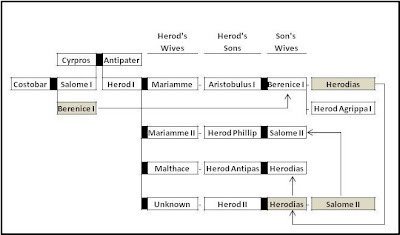
Such inter-marrying within extended family has always been an accepted practice among royalty as a way of keeping the family bloodline pure. The relationships between the Caesars were equally convoluted. We find the royal houses of Europe doing much the same thing during the height of European monarchy. Strangely enough, as World War I loomed King George of England, Czar Nicholas of Russia, and Kaiser Wilhelm of Germany — or Georgie, Nicky and Willy, as they called each other — were all first cousins. So, exactly why did they find it necessary to go to war?
HEROD ANTIPAS BUILDER OF CITIESShortly after Herod the Great's death, while Antipas was in Rome making his case before Caesar Augustus, the Messianic pretender Judas the Galilean led an uprising. His rebels armed themselves with weapons stolen from the Sepphorian armory. In the subsequent suppression of the revolt by the Romans, Syrian Governor Quinctillius Varus carried away the residents of Sepphoris into slavery. The city was sacked, burned and leveled.
Antipas returned from Rome to find Sepphoris a barren wasteland. Following in his father's footsteps, he decided to become a master builder and developer of cities. He rebuilt Sepphoris from the ground up making it his first capitol. Because the city had few residents, he brought in many non-Jewish immigrants to populate it. The result was a city rebuilt to Roman standards with baths, amphitheatres, a hippodrome and his palace.
HELP WANTED: CARPENTERS & CARPENTER'S HELPERSInterestingly, the closest village to Sepphoris was Nazareth…only about an hour's walk away. Because of the immense building activity taking place in Sepphoris, and since Joseph was a έκτων, tektōn…a craftsman in wood or carpenter, (Matthew 13:55) it seems probable that he and his foster son, Jesus, might find work there. The implications here are enormous. Most people imagine the boy Jesus assisting Joseph in a humble little carpentry next to their home. What if instead, they worked in the cosmopolitan atmosphere of Sepphoris surrounded by Greeks and Romans, pagan Temples, and baths? If we read the subtext of the Gospels, we quickly notice that Jesus was not some rural hick. In addition to being literate and a Torah scholar, Jesus was multi-lingual, socially aware, and sophisticated in his understanding of society and the world at large. Sepphoris sat astride major trade routes from the East. Could exposure to the cosmopolitan culture of Sepphoris have given him this breadth of knowledge?
BUTTERING UP THE EMPERORAntipas also made major renovations and added a city wall to Betharamphtha (Bethharem), a city in Perea. He then renamed it Julias in honor of Julia, the wife of the Emperor Augustus and mother of Tiberius. He took the fortress Macherus on the eastern shore of the Dead Sea and created a city around it, erecting a magnificent palace there. It was most likely this palace where John the Baptist was imprisoned and executed. In another effort to curry favor in Rome, when Antipas constructed his new capitol on the Sea of Galilee in AD 17, he named the city Tiberias. It was later discovered he'd built the city atop an old Jewish graveyard. Since no pious Jew would enter Tiberias, he populated it with Greeks and Romans.
Josephus explains it like this: "He even liberated many in many places, granting them land and supplying houses from his own means, on the condition that they would not leave the city, knowing that (this) settlement was against the Torah and the heritage of the Jews, since the foundation of Tiberias was over tombs — of which there were many — that were obliterated. Our Law declares these settlers to be defiled for seven days." Josephus, Antiquities 18:38
PILATE SENDS JESUS TO HEROD ANTIPASLike his father, Antipas liked to appear an observant and believing Jew to ingratiate himself with his subjects. Also like his father, it's doubtful he truly observed a Torah lifestyle when out of the public eye. Like his brothers, he'd been raised in Rome and depended upon the Emperor's benevolence for his position as tetrarch. Antipas did, however, make it a practice to travel to Jerusalem for the major pilgrim feasts, and so he was in Jerusalem on the day Pilate tried Jesus. When Pilate learned that Jesus was from Galilee, he sent him to Antipas. (Luke 23:6-12) There was no legal precedent for such a move. Pilate most likely wanted to foist the whole thing off on someone else.
Rather conducting a trial, Antipas wanted Jesus to entertain him with miracles. Jesus never spoke a word to him. Antipas and his soldiers mocked and ridiculed Jesus, before sending Him back to Pilate.
ALL GOOD THINGS MUST COME TO AN ENDHerod Antipas ruled as tetrarch for 43 years before he ran out of friends in Rome. He'd been appointed by Augustus and served throughout Tiberius' reign. But by AD 39 both of his patrons were dead and Caligula was Emperor. When Antipas' half-brother, Herod Phillip, died Caligula appointed his boyhood friend, and Antipas' brother-in-law, Herod Agrippa to fill the vacancy. He even gave him the title of King. This upset Agrippa's sister, Herodias. She pestered Antipas to go to Caligula and demand they be made King and Queen.
But the move backfired. Unbeknownst to her, Agrippa had been undermining Antipas and telling Caligula he was planning a revolt. He said Antipas had amassed weapons sufficient for an army of 70,000 men. Antipas undoubtedly did have a large cache of weapons. He had to beat back continual border skirmishes with Nabatea and the Galilean hills were full of highwaymen and roaming bands of Zealots…remnants of Judas the Galilean's original army. This provided Caligula with an excuse to rid himself of Antipas and reward his friend Agrippa. Antipas was stripped of his power and exiled to Gaul. Conveniently, his territories were combined with what King Agrippa already had. In short order Agrippa was made ruler of the entirety of his grandfather's former kingdom.
Interestingly, Caligula offered to let Herodias remain in Rome where she would be supported at state expense. She chose to accompany her husband into exile instead. So at 60 years of age, after a life amid power and pomp, Antipas set sail for Gaul to live out his final years in obscurity.
Next time, we conclude this short series on The Who Tried Jesus with Ponius Pilate.
Until then, we wish you Peace and Blessings.
If you reached this post via a link, click the HOME tab above to see other recent posts and visit our archives.
Published on March 23, 2012 01:00
March 21, 2012
THE MEN WHO TRIED JESUS: CAIAPHAS
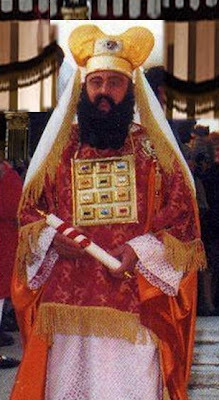
Hello My Friend and Welcome.
We continue our study of The Men Who Tried Jesus with a look at the High Priest, Joseph Caiaphas. There are several things that need to be clarified going in. First, Caiaphas was the High Priest at the time of Jesus' death, not Annas. The Bible refers to Annas as the High Priest in an honorary way just as Presidents of the United States are still addressed as Mr. President even after they leave office. That, of course, does not deny the fact that Annas remained the power behind the throne. This would be especially true in the case of Caiaphas since he was married to Annas' daughter. Though we know little of Caiaphas' background, we can assume he must have come from a wealthy and prominent family to have been considered worthy to enter the House of Annas via marriage.
THE MAN WHOSE NAME NO ONE KNOWSThe word Caiaphas, like all Greek and Hebrew words, is a transliteration. Joseph is generally called by his Greek name Caiaphas in the Bible, which indicates this was probably how First Century Jews referred to him. That the High Priest should be known by a Greek rather than a Hebrew name is another example of the extensive Hellenization of Jewish society at that time. The name Caiaphas has never been adequately translated. Some have speculated that it is a family name. Others have suggested it means rock or depression. It is clearly not a translation of Kepha, or Peter, but it could be Kayapha, Kaipha or Kaiphah. The Mishnah names him Kayaph which Edersheim suggests means, He who is at the top. There are also references to the Chaldean word for Israelite, Cajepham. The point is, we really don't know.
A SKILLED POLITCAL OPERATIVEWhat little we do know of the man indicates he was a thug and a brute who ignored established rules whenever expedient…definitely not someone with high moral standards or a commitment to fairness. As we said when discussing his father-in-law, Annas, with the coming of the Romans the office of High Priest became decidedly political. And, if nothing else, Caiaphas appears to have been the consummate politician. During the era of the Herodians and Romans —a period spanning 107 years— no one held the office of High Priest longer than Caiaphas. He was High Priest for 18 of those years while the average term in office was less than 2 years 9 months.
Caiaphas was there when Pontius Pilate arrived and didn't leave until both he and Pilate were dismissed by the Syrian governor, Vitellius. Pilate's removal was instigated by his ordering troops into Samaria to attack a peaceful assembly of Samaritans. The contentious relationship between Jews and Samaritans is well known. There are indications that Pilate was mislead as to the nature and intent of this gathering making him a tool the Jews used against their Samaritan enemies. There is no way to know whether or not Caiaphas had a hand in this scheme. However, for Vitellius the possibility of Jewish involvement provided sufficient grounds for him to remove both the Prefect and the High Priest.
MOVING TO CENTER STAGECaiaphas has a principal role in the Passion narratives in all four Gospels. John tells us that after Annas questioned Jesus he was taken to Caiaphas' home. This action begins a long series of violations of Jewish law that occurred during the trial of Jesus of Nazareth. He was taken at night from the Garden of the Gethsemane even though arrests and trials were forbidden at night. Jesus was also bound while the law stipulated only a condemned prisoner could be bound. The private interrogations conducted by both Annas and Caiaphas also ran counter to established law. Jesus was tried the day following his arrest, the day of preparation for the Shabbat Chol HaMoed Pesach ―the Sabbath during the feast of Passover― the most sacred Shabbat of the year. Once started, a trial could not be adjoined for longer than overnight. And, since a trial could not be held on the Sabbath, no trials were allowed to begin on the day before the Sabbath…Friday.
The most blatant example of Caiaphas' disregard for the Law occurs in Matthew 26:63-64. "And the high priest said to Him, 'I adjure you by the living God, that you tell us whether you are the Christ, the Son of God.' Jesus said to him, 'You have said it yourself; nevertheless I tell you, hereafter you will see the Son of Man sitting at the right hand of Power and coming on the clouds of heaven." Then the high priest tore his robes and said, 'He has blasphemed!'" Jewish Law, like the Fifth Amendment of the United States Constitution, protected a person from self-incrimination. Caiaphas had no right to try to extort a confession or to force a defendant to admit guilt, yet this was how he finally convicted Jesus.
ISRAEL'S LAST PROPHETThe Bible and the history of the Jews is filled with Prophets and Prophecy. The phenomenon of Israelite prophecy ended with the crucifixion of Jesus of Nazareth. Who was Israel's final prophet? It was not Malachi. Strangely enough, it was Joseph Caiaphas. Perhaps the most interesting aspect of this event is that Caiaphas, in stating a simple fact never realized he was also prophesying. But as Peter 1:21 says, "…no prophecy ever came from man's own initiative."
John explains: " Caiaphas, who was high priest that year, said to them, 'You know nothing at all; you do not understand that it is expedient for you that one man should die for the people, and that the whole nation should not perish." He did not say this of his own accord, but being high priest that year he prophesied that Jesus should die for the nation, and not for the nation only, but to gather into one the children of God who are scattered abroad. So from that day on they took counsel how to put him to death." John 11:49-53
It is also interesting to note that this last prophecy occurred under the Old Covenant. It was at the Last Supper that Jesus instituted the New Covenant. Ironically, Caiaphas' action of killing one man to save many ultimately led to Jerusalem's destruction. As Jesus says in Luke 19:43-44: "The days will come upon you when your enemies will build an embankment against you and encircle you and hem you in on every side. They will dash you to the ground, you and the children within your walls. They will not leave one stone on another, because you did not recognize the time of God's coming to you."
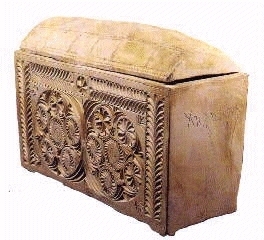 The Caiaphas Ossurary
The Caiaphas OssuraryFROM DUST YOU CAME AND TO DUST YOU SHALL RETURN In 1990 an ornately decorated limestone ossuary (bone box) was found in Jerusalem's Peace Forest. Inside the ossuary were the bones of two babies, a adolescent child, a teenage boy, an adult woman, and a man about 60years of age. Inscribed on the ossuary were the words Yehosef bar Kayafa," which translates to Joseph, son of Caiaphas.
Many scholars have concluded that the bones of the elder man belonged to the famous Caiaphas, High Priest in Jerusalem at the point of Jesus' crucifixion. The bones were reburied on the Mount of Olives. Excavator Zvi Greenhut of the Israeli Antiquities Authority recovered the artifact, which is now on display at the Israel Museum in Jerusalem.
After Caiaphas and the Sanhedrin finished with Jesus, his trial moved from the religious arena into the political one. Next time we will examine the Roman Prefect who will always be remembered for his actions that day and is immortalized in the phrase, "…suffered under Pontius Pilate, was crucified, died and was buried."
Until then, we wish you Peace and Blessings.
If you reached this post via a link, click the HOME tab above to see other recent posts and visit our archives.
Published on March 21, 2012 01:00
March 19, 2012
THE MEN WHO TRIED JESUS: ANNAS
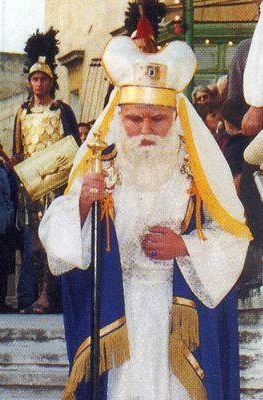
Hello My Friend and Welcome.
During the trial that led to his crucifixion, at one time or another Jesus stood before four men. Taken together, they represented Jewish political and religious authority as well as the power of Rome. Today we begin a four-part series devoted to The Men Who Tried Jesus. We begin with Annas ben Seth. Although he is mentioned in all four Gospels, John alone tells us that upon his arrest Jesus was first taken to Annas. "First they led him to Annas; for he was the father-in-law of Caiaphas, who was high priest that year." John 18:13
ANNAS COMES TO POWERAnnas, in Hebrew Hanan, was born in 22 BC, making him about 18 years old when Herod the Great died. After their father's death, Herod's sons, Herod Phillip and Herod Antipas were made tetrarchs and another son, Herod Archelaus, was made ethnarch of Judea. Archelaus turned out to be a particularly inept ruler and was deposed and exiled in 6 AD by Caesar Augustus. From that point forward the Romans appointed all High Priests and the office became more a political plum than one of religious authority.
Following Archelaus' dismissal, Quirinius, the Governor of Syria, removed the High Priest Joazar ben Boethus from office. He appointed Annas ben Seth in his stead. We know little about Annas' family and background prior to his becoming High Priest. The family name could indicate ties with Antioch, which had a large and influential Jewish population. He held the High Priesthood for nine years before being ousted by the Prefect Gratus "for imposing and executing capital sentences which had been forbidden by the imperial government."
CAPO DEI CAPI — THE BOSS OF THE BOSSESAnnas lived during one of the most tumultuous periods in Jewish history, and the House of Annas continued to influence the course of history throughout the time when the Romans ruled Jerusalem. He lost the High Priesthood for ordering the stoning of a young Sabbath-breaker. This action gives us insight into his temperament and approach to problem solving and explains why he dealt with Jesus the way he did. In the years after his removal from office, Annas became a sort of Capo dei Capi, pulling strings and controlling affairs through his sons and son-in-law.
The House of Annas controlled the High Priesthood, and with it Jerusalem and the Jews, throughout most of Annas' lifetime. Consider the following list of High Priests:
Annas ben Seth (6–15) FatherEleazar ben Hanon (16–17) SonJoseph ben Caiaphas (18–36) Son-in-LawJonathan ben Hanon (36–37) SonTheophilus ben Hanon (37–41) SonMatthias ben Hanon (43) SonAnanus ben Hanon (63) Son
By 63 AD the Temple and Jerusalem politics were in chaos and the country was hurtling toward the outbreak of the Great Jewish Revolt which culminated in the destruction of the Temple and the sacking of Jerusalem by the armies of Vespasian and Titus.
HATED AND CURSED IN HIS OWN LIFETIMEIn his book, The Life and Times of Jesus the Messiah, Alford Edersheim says the House of Annas was cursed in the Talmud as "wealthy, unscrupulous and corrupt leaders of the priesthood whose presence defiled the sanctuary." Annas was a leading member the First Century Judean aristocracy and known as arrogant and ambitious. He used his enormous wealth to maintain political control. The Talmud records a popular rhyme of the era which described the House of Annas: Woe to the house of Annas! Woe to their serpent's hiss! They are High Priests; their sons are keepers of the treasury, their sons-in-law are guardians of the temple, and their servants beat people with staves." (Pesahim 57a)
Pharisaism was the predominate sect of Judaism in the First Century, yet all High Priests of the House of Annas were Sadducees. This alone set up a conflict between the ruling class and those under them. Unlike the Pharisees, the Sadducees didn't recognize the Prophets as authoritative representatives of God. Therefore they did not believe in things such as the timing of the coming of the Messiah found in Daniel's prophecy of the weeks, Daniel 9:24-27, the Suffering Servant of Isaiah 53, or even a bodily resurrection.
THE SOURCE OF THE FAMILY FORTUNEThe family gained much of their wealth from the four booths of the sons of Annas, which were market stalls located on the Mount of Olives. They also had other market stalls inside the temple complex in the Court of the Gentiles. Through these, they maintained a monopoly on the sale of sacrificial animals, as well as the exchange of foreign money into temple coins for the offerings. This enabled them to charge exorbitant prices, effectively amassing wealth through the exploitation and oppression of the poor.
When Jesus cleansed the Temple, he effectively declared war on the House of Annas. He raised their ire by striking at the source of their wealth and like a typical Mafia chieftain, Annas responded with violence. "And they came to Jerusalem. And he entered the temple and began to drive out those who sold and those who bought in the temple, and he overturned the tables of the money-changers and the seats of those who sold pigeons; and he would not allow anyone to carry anything through the temple. And he taught, and said to them, 'Is it not written, "My house shall be called a house of prayer for all the nations"? But you have made it a den of robbers.' And the chief priests and the scribes heard it and sought a way to destroy him; for they feared him…"
John briefly records the trial before Annas with few details. Annas interrogated Jesus about his teaching and Jesus was struck on the mouth for challenging the way the trial was being conducted. Although Annas does not appear to play a leading role in the trial of Jesus, he most likely was the one responsible for his arrest, trial and crucifixion. True to form, he would have let others do the dirty work while he remained behind the scenes pulling strings and directing events.
Though he did everything in his power to stamp it out, Annas lived long enough to see Christianity rise and flower. He died in AD 66 at age 88 when the First Jewish Revolt was in its earliest stages. Fittingly, he was assassinated by members of the radical Secarii party when he advocated for peace with Rome.
STRIKING DOWN THE BISHOP OF JERUSALEMIn another interesting historical quirk, his son, Annas ben Annas known as Annas II, was High Priest when James the Just, Bishop of Jerusalem was killed in AD 62. Josephus describes him as "a bold man in his temper, and very insolent; he was also of the sect of the Sadducees, who were rigid in judging offenders." Josephus Ant 20:199 Annas II (most probably at his father's command) made a last, desperate strike at the Christians following the death of the Roman Procurator Festus. He lodged accusations against James before Festus' replacement arrived. James was subsequently stoned to death. The citizens objected and Herod Agrippa I removed him from office, replacing him with Joshua ben Damneus. And so, fifty-seven years of domination by the House of Annas finally came to an end. Josephus Ant 20:200-203
Next time we will look at the second man in this deadly chain of events, Annas' son-in-law Joseph Caiaphas.
Until then, we wish you Peace and Blessings.
If you reached this post via a link, click the HOME tab above to see other recent posts and visit our archives.
Published on March 19, 2012 01:00
March 16, 2012
PROPHECIES OF PALM SUNDAY, GOOD FRIDAY AND EASTER
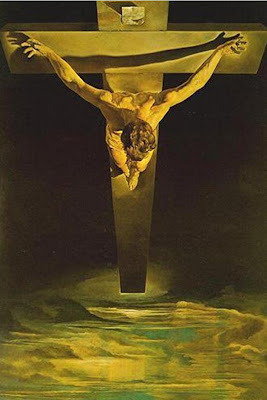
Hello My Friend and Welcome.
Our Lenten and Easter Series continues today with an examination of a few prophecies that reference three highlights of this penitential season: Palm Sunday, Good Friday and Easter Sunday. Entire books have been written on Biblical prophecy, and the following references are, in most cases, one or two among many.
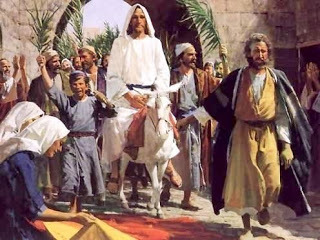
PALM SUNDAY
On the first day of the week of his crucifixion, Jesus entered Jerusalem riding on the back of a young mule. His disciples laid their cloaks on the ground in front of him and the people cut palm branches and waved them in the air shouting, "Hosanna to the Son of David! Blessed is he who comes in the name of the Lord! Hosanna in the highest!" Why did Jesus do this? What was its symbolic meaning?
The event itself is foretold in Zechariah 9:9-10. "Rejoice greatly, O daughter of Zion! Shout aloud, O daughter of Jerusalem! Lo, your king comes to you; triumphant and victorious is he, humble and riding on an ass, on a colt the foal of an ass. I will cut off the chariot from Ephraim and the war horse from Jerusalem; and the battle bow shall be cut off, and he shall command peace to the nations; his dominion shall be from sea to sea, and from the River to the ends of the earth."
The symbolism of this event is reflected in 1Kings in which David declares Solomon his successor. By seating him on his own mule, David gave a sign to the people that Solomon was the legitimate heir to the throne rather than Adonijah, his brother. Solomon can be seen as a type for Christ. Hence, Jesus re-enacted the event establishing himself as the heir to the throne of David. Why a mule? Mules are a cross between a mare and a male donkey. Since crossbreeding was prohibited in Israel (Lev 19:19), mules were likely imported, making them highly valued.
1Kings 1:38 "Then King David answered, "Call Bathsheba to me." So she came into the king's presence, and stood before the king. And the king swore, saying, "As the LORD lives, who has redeemed my soul out of every adversity, as I swore to you by the LORD, the God of Israel, saying, 'Solomon your son shall reign after me, and he shall sit upon my throne in my stead; even so will I do this day.' King David said, "Call to me Zadok the priest, Nathan the prophet, and Benai'ah the son of Jehoi'ada." So they came before the king. And the king said to them, 'Take with you the servants of your lord, and cause Solomon my son to ride on my own mule, and bring him down to Gihon; and let Zadok the priest and Nathan the prophet there anoint him king over Israel; then blow the trumpet, and say, `Long live King Solomon!'"
GOOD FRIDAYAs an aside, this illustration of the crucifixion (one of my personal favorites) is by Salvatore Dali. Though the name Dali brings to mind melting clocks and strange images, he was clearly capable of great and inspiring work.
Isaiah's prophecies of the suffering servant are the most familiar relating to the crucifixion.
Isaiah 53:5-7 "But he was wounded for our transgressions, he was bruised for our iniquities; upon him was the chastisement that made us whole, and with his stripes we are healed. All we like sheep have gone astray; we have turned every one to his own way; and the LORD has laid on him the iniquity of us all. He was oppressed, and he was afflicted, yet he opened not his mouth; like a lamb that is led to the slaughter…"
Interestingly, that is immediately followed by a prophecy relating to the Jesus' burial in Joseph of Arimthea's tomb. Isaiah 53:9 "And they made his grave with the wicked and with a rich man in his death, although he had done no violence, and there was no deceit in his mouth."
There is also Zechariah 12:10 "…when they look on him whom they have pierced, they shall mourn for him, as one mourns for an only child, and weep bitterly over him, as one weeps over a first-born."
The following passage from Amos ties the crucifixion to the High Holydays of the Passover.
Amos 8:10 "I will turn your feasts into mourning, and all your songs into lamentation; I will bring sackcloth upon all loins, and baldness on every head; I will make it like the mourning for an only son, and the end of it like a bitter day."
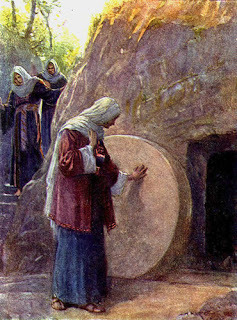
THE RESURRECTIONThere are a number of Old Testament passages referring to what is usually called the General Resurrection…that is the resurrection of all people on the Day of the Lord, and most people in Jesus' time believed in such a resurrection. However, specific passages referring to a unique resurrection for the Messiah are sparse. Jesus himself pointed us to one, Jonah, whose escape from the whale's belly foreshadowed the Messiah's resurrection.
Matthew 12:38-40 "Then some of the scribes and Pharisees said to him, 'Teacher, we wish to see a sign from you.' But he answered them, 'An evil and adulterous generation seeks for a sign; but no sign shall be given to it except the sign of the prophet Jonah. For as Jonah was three days and three nights in the belly of the whale, so will the Son of man be three days and three nights in the heart of the earth.'"
We also find a pointer in Acts 2:25 to Psalm 16:9-10 "For David says concerning him, 'I saw the Lord always before me, for he is at my right hand that I may not be shaken; therefore my heart was glad, and my tongue rejoiced; moreover my flesh will dwell in hope. For thou wilt not abandon my soul to Hades, nor let thy Holy One see corruption…'"
In this passage from Hosea the Messiah himself seems to be speaking.
Hosea 6:2 "After two days he will revive us; on the third day he will raise us up, that we may live before him."
We hope you've enjoyed this short overview. A Google search for Messianic passages will yield many, many more.
OurLenten series continues on Monday with a series of four posts taking a close look at each of the men who tried Jesus.
Until then, we wish you Peace and Blessings.
If you reached this post via a link, click the HOME tab above to see other recent posts and visit our archives.
Published on March 16, 2012 01:00
March 14, 2012
CHRISTIAN WRITER'S BLOG CHAIN - SAVOR

Hello My Friend and Welcome. Today is our turn on the Christian Writer's Blog Chain. This month's word is savor and, as usual I'll slant my comments to the writing life. We live in the Coos Bay-North Bend area on Oregon's South Coast. The city of Coos Bay, originally named Marshfield, surrounds North Bend on three sides. The fourth side is water. Marshfield existed first and then, in 1903, Timber Baron, Louis Simpson, founded a new town at the north bend of the Coos Bay and named it accordingly. North Bend currently has approximately 9.700 people. The 1910 census credited the new town with slightly over 2,000. It steadily increased to a peak of 9,779 in 1980 and has pretty much stayed there.
 Ship Loading Logs for Export on North Bend's BayfrontBecause I find myself between projects, my long-suffering spouse has been asking, "Didn't you promise a play day once your book came out?" To which I can only answer, "Yes, Dear."
Ship Loading Logs for Export on North Bend's BayfrontBecause I find myself between projects, my long-suffering spouse has been asking, "Didn't you promise a play day once your book came out?" To which I can only answer, "Yes, Dear." We both savor life here on the Oregon Coast and a play day for us means visiting some of our favorite attractions that the area has to offer.
 The McCullough Bridge Crosses the Bay into North BendSo today, I thought I'd take you along when we go to some of our favorite spots, but with a little twist. My book LOST is set on the Southern Oregon Coast in the mythical town of Pine Crest, which coincidentally bears a strong resemblance to North Bend. Interestingly enough, my characters also visit some of our favorite places. Small world, huh? But rather than tell about these places or add captions to the photos, I'll use excerpts from the book to annotate the tour. I hope you enjoy your day on Oregon's Bay Area. Be sure to fasten your seatbelt...it's there on your left.
The McCullough Bridge Crosses the Bay into North BendSo today, I thought I'd take you along when we go to some of our favorite spots, but with a little twist. My book LOST is set on the Southern Oregon Coast in the mythical town of Pine Crest, which coincidentally bears a strong resemblance to North Bend. Interestingly enough, my characters also visit some of our favorite places. Small world, huh? But rather than tell about these places or add captions to the photos, I'll use excerpts from the book to annotate the tour. I hope you enjoy your day on Oregon's Bay Area. Be sure to fasten your seatbelt...it's there on your left.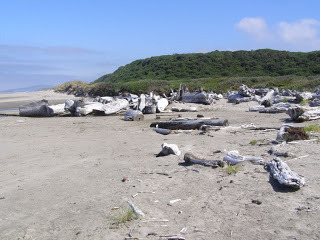 Eddie carried a bag with sodas, crackers and a smoked fillet of albacore tuna they'd bought at a fish market. It was the middle of the week and the two men had the beach pretty much to themselves. The air was clear and crisp under a partly cloudy sky and the tide was on its way out. As it receded, it left behind a wide expanse of firm, damp sand for them to walk on.
Eddie carried a bag with sodas, crackers and a smoked fillet of albacore tuna they'd bought at a fish market. It was the middle of the week and the two men had the beach pretty much to themselves. The air was clear and crisp under a partly cloudy sky and the tide was on its way out. As it receded, it left behind a wide expanse of firm, damp sand for them to walk on. After they'd walked a while, Tom noticed a large drift log partially buried in the sand, an impromptu picnic table. The men straddled the log facing each other and unwrapped their lunch. Despite a steady breeze coming off the water, the air around them filled with the smell of the cured and smoked fish.
 A Chopper from Coast Guard Air Station North BendHe handed the guard a business card. "I have an appointment with Captain Harrison."The guard scanned the day log, found his name and picked up the phone to notify them inside. "Someone will be out to escort you into the building." The sudden high-pitched whine of a jet engine precluded further conversation. On the other side of a high fence, one of the Coast Guard's HH65A Dolphin helicopters revved its engines in preparation for takeoff. Tom stepped to the fence to watch. The red-orange chopper slowly rose into the air. It hovered a few feet above the tarmac for several long moments as if suspended by an invisible wire. Then its nose swung around and the craft quickly lifted up and away from the base in a northwesterly direction. Once they attained sufficient altitude, they leveled out, swept across the bay, and vanished over the crest of the dunes.
A Chopper from Coast Guard Air Station North BendHe handed the guard a business card. "I have an appointment with Captain Harrison."The guard scanned the day log, found his name and picked up the phone to notify them inside. "Someone will be out to escort you into the building." The sudden high-pitched whine of a jet engine precluded further conversation. On the other side of a high fence, one of the Coast Guard's HH65A Dolphin helicopters revved its engines in preparation for takeoff. Tom stepped to the fence to watch. The red-orange chopper slowly rose into the air. It hovered a few feet above the tarmac for several long moments as if suspended by an invisible wire. Then its nose swung around and the craft quickly lifted up and away from the base in a northwesterly direction. Once they attained sufficient altitude, they leveled out, swept across the bay, and vanished over the crest of the dunes. The drive to the Eugene meandered through the Umpqua River valley. The river steamed with patchy, morning fog. Traffic was light, the scenery beautiful. On Highway 38 east of Reedsport, they passed a large herd of elk. Charlie popped his head up in the back seat when Marty called them to Tom's attention. The dog scrutinized the large animals, gave a soft woof then settled back to resume his nap.
The drive to the Eugene meandered through the Umpqua River valley. The river steamed with patchy, morning fog. Traffic was light, the scenery beautiful. On Highway 38 east of Reedsport, they passed a large herd of elk. Charlie popped his head up in the back seat when Marty called them to Tom's attention. The dog scrutinized the large animals, gave a soft woof then settled back to resume his nap.  Eddie left Tommy's and drove to Charleston. He turned onto a small road that skirted the slough and parked alongside a metal-sided building. The gray, windowless building was two stories high with sliding doors front and back. Orange rust stains on its tall metal walls indicated where the gutters leaked. Oil drums, a rusting anchor, cable spools and other paraphernalia lay scattered along the side of the building.Eddie heard voices and pounding inside. He slid the door open a crack and stepped through. He slowly approached the large blue ship that filled the room and stood with his hands in his pockets staring up at its bow.Bright overhead lights illuminated the work area and heavy blocking and stanchions supported the ship. They'd set ladders against its sides. Equipment, parts, coils of electrical wire and toolboxes lay around the base of each ladder. Multiple electrical extension cords snaked across the floor and up and over the ship's gunnels.
Eddie left Tommy's and drove to Charleston. He turned onto a small road that skirted the slough and parked alongside a metal-sided building. The gray, windowless building was two stories high with sliding doors front and back. Orange rust stains on its tall metal walls indicated where the gutters leaked. Oil drums, a rusting anchor, cable spools and other paraphernalia lay scattered along the side of the building.Eddie heard voices and pounding inside. He slid the door open a crack and stepped through. He slowly approached the large blue ship that filled the room and stood with his hands in his pockets staring up at its bow.Bright overhead lights illuminated the work area and heavy blocking and stanchions supported the ship. They'd set ladders against its sides. Equipment, parts, coils of electrical wire and toolboxes lay around the base of each ladder. Multiple electrical extension cords snaked across the floor and up and over the ship's gunnels.
Those stormwatchers who went to Shore Acres State Park got what they came for. The wind whipped the incoming tide into frothy whitecaps and sent waves smashing against the cliffs with the chest thumping intensity of summer fireworks. Huge plumes of water roared up the sides of the steep, rocky ledges leaping a hundred feet into the air before crashing down on the storm-watchers. Farther north, gusts swept across the dunes turning sand into buckshot and bowing solitary shore pines till they threatened to snap.

We hope your enjoyed your short visit to the Oregon Coast and will come back soon. The weather's mild here - winter lows in the 40's and highs in the mid 50's. In the summer the temp soars to the mid 60's with an overnight low of about 50. Of course, on a stormy day at Shore Acres it can feel a lot colder.
P.S. In all fairness, I am forced to admit that after I posted this a freak winter storm swept in Monday night bringing with it six inches of snow. We were also without power until 4:00 PM on Tuesday. Lights are back on and the snow is melting like crazy. High for the day was 48...nothing like life on the South Coast.
Next time we'll resume our Lenten/Easter series with the prophecies of Palm Sunday, Good Friday and Easter.
Until then, we wish you Peace and Blessings.
If you reached this post via a link, click the HOME tab above to see other recent posts and visit our archives.
Published on March 14, 2012 01:00
March 12, 2012
THE ORIGIN OF THE TERM EASTER
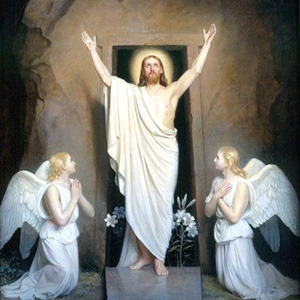
Hello My Friend and Welcome.
THE DANGERS OF A LITTLE BIT OF KNOWLEDGEThis is as good a time as any to deal with the overall concept of Easter. As we found in our December study on All Things Christmas, there are many half-truths and misconceptions surrounding the traditions and practices of the Church. People perpetuate these falsehoods either out of ignorance or because it discredits the Church and, by discrediting the Church, they gain credibility.
In the case of Christmas, it was the false fact that Christmas was placed on December 25th because that date corresponded with pagan solstice feasts. We disproved that in our post Why Dose Christmas Come on December 25th? If you missed the post, you can find it HERE.
Easter, too, we are told is a pagan holiday. As Easter approaches and you'll hear this refrain repeated over and over. For the sake of charity, we'll assume that the people saying this are simply misinformed.
REFUTTING THE PAGAN MYTHFirst of all, while we cannot be certain when Jesus of Nazareth was born, we know with certainty when he died. Easter is known as The Pascha everywhere except in the English speaking world. Pascha is Greek for Passover…the day on which Jesus was crucified. But didn't pagans have Spring festivals? Of course they did. Many small towns have a Fall Harvest Festival…an Apple Fest, a Pumpkin Show, etc. Are these festivals a ritualistic way of paying homage to the Earth Goddess, or simply an opportunity for family fun and food from traveling food booths?
So where did the connection of Easter and paganism come from? It began with the observations of an 8th Century Christian writer. Again, like the Christmas speculation, a passing comment took on a life of its own. In this case, the Venerable Bede said that the word Easter was derived from the name of the pagan goddess Eostre, whose name was in turn derived from the Norse word for Spring, Eastre. So Easter comes from Spring, which seems appropriate enouh. Note, he was talking about the word Easter, not the Easter practices.
But what about those practices? Those boiled eggs in a basket of grass, etc? Doesn't that perpetuate some pagan equinox worship service? Let's take a closer look. Circadian rhythms are biological processes that are dependent upon day length. Modern egg producers stimulate the hen's laying cycle by extending the perceived day length with artificial light. People living in the First Century didn't have this luxury; they had to depend upon the natural cycle of solstices and equinoxes. Consequently, as the days grew longer with the coming of Spring, their hens were stimulated to begin laying. Also, during the 40-day period of fasting preceding Easter, the Early Christians did without meats, fats and eggs.
What could be more opportune? Just as we move into Spring and the celebration of the Resurrection, the hens begin to produce eggs again. Eggs, of course, are ideal representations of a resurrection of sorts when they hatch and of the new life the Early Christians found in Christ. Interestingly, the Early Christians dyed boiled eggs red —for the saving blood of Jesus Christ. They presented them to their children on Easter morning as a reminder of the Paschal mystery of Christ's death and resurrection. Easter morning, of course, was also the first day that eggs could be eaten again.
This year when you boil and color eggs with your children or grandchildren, tell them the story of the Early Christians. Remind them that, like those children of earlier times, they are participating in a holy tradition. Remind them also that those Early Christian children never had chocolate.
Next time we will examine the prophecies surrounding the Messiah and his death and resurrection.
Until then, we wish you Peace and Blessings.
If you reached this post via a link, click the HOME tab above to see other recent posts and visit our archives.
Published on March 12, 2012 01:00
March 7, 2012
THE JEWISH FEAST OF PURIM
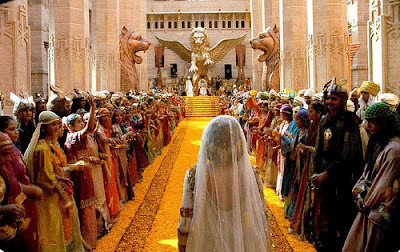 Esther Enters to See the King in the Movie
One Night With the King
Esther Enters to See the King in the Movie
One Night With the King
Hello My Friend and Welcome.
We take a short pause in our Lenten/Easter Posts to look at another of the Jewish Feasts and Festivals, Purim. This celebration always begins on the 14th day of the Jewish month of Adar…which comes in late winter or early spring. This year, Purim begins at sundown Wednesday, March 7th , and lasts until sundown on March 8th — Purim Day.
THE BOOK OF ESTHERThe word Purim means lots and refers to the lottery Haman used to choose the date for the massacre of the Jews. Purim is preceded by a short fast as a memorial to Esther's fast before she approached the king. Each year, the entire Megillah, as the book of Esther is known, is read in the synagogue on this day.
The heroes of the story are Hadassah (Esther), a beautiful young Jewish woman living in Persia, and her older cousin Mordecai, who raised her as if she were his daughter. Esther was taken to the house of Ahasuerus, King of Persia, to become part of his harem. However, King Ahasuerus fell in love with Esther and made her his queen not knowing that she was a Jew. At Mordecai's urging she speaks to the king on behalf of the Jewish people, saving them from annihilation.

Hadassah's story has been told and re-told in books and movies including the 2006 release, One Night with the King, starring Tiffany DuPont, Luke Goss, John Noble, and Omar Sharif. The picture at the top of this post is from that movie. Big Idea Productions also produced a Veggie Tales version called Esther, The Girl Who Became Queen.
NO GOD?The book of Esther is unusual in that it is the only book of the Bible that does not contain the name of God. In fact, it includes virtually no reference to God. Mordecai makes a vague reference to the fact that the Jews will be saved by someone else, if not by Esther, but that is the closest the book comes to mentioning God. Thus, one important message that can be gained from the story is that God often works in ways that are not apparent and appear to be chance, coincidence or ordinary good luck.

CELEBRATING WITH HAMENTASCHENPurim is a day of festivity, frivolity and celebration. It is customary to hold carnival-like celebrations, perform plays and parodies, and hold beauty contests. Traditional Purim treats are triangular fruit-filled cookies. Known as hamentaschen, they are supposed to represent Haman's three-cornered hat. They are available in most Jewish delicatessens. If you'd like to try making them at home, here's a recipe:
Ingredients: 2/3 C butter or margarine, 1/2 C sugar, 1 egg, 1/4 C orange juice (pulp free, not pulpy), 1 C white flour, 1 C whole wheat flour (DO NOT substitute white flour. The whole wheat flour is necessary to achieve the right texture.), 2 tsp baking powder, 1 tsp. cinnamon.
Various preserves, fruit butters and/or pie fillings.
Process: Cream butter and sugar together, add egg and blend thoroughly. Blend in orange juice. Combine the baking powder and cinnamon with the white flour. Add flour a ½ cup at a time, alternating white and wheat, blending thoroughly between each. Refrigerate batter overnight or at least a few hours. Roll as thin as you can without getting holes in the batter (roll it between two sheets of wax paper lightly dusted with flour for best results). Cut out 3 or 4 inch circles.
Put a dollop of filling in the middle of each circle. Divide the circle into three equal parts and fold in the three sides to make a triangle, folding the last corner under the starting point, so that each side ends up with a corner that folds over and a corner that folds under (see picture above). Folding in this "pinwheel" style will reduce the likelihood that the last side will fall open while cooking, allowing filling to spill out. It also tends to make a better triangular shape.
Bake at 350 degrees for about 15-20 minutes, until golden brown but before the filling boils over.
Traditional fillings are poppy seed and prune, but apricot works well. Apple butter, pineapple preserves, and cherry pie filling also work quite well. The number of cookies this recipe makes depends on the size of your cutting tool and the thickness you roll. A 4-1/4 inch cutting tool and rolling to a medium thickness, yields 20-24 cookies.
MODERN ECHOES OF PURIMIn the time of the Book of Esther, Haman tried to destroy the Jews. In modern times, there have been two significant figures who have threatened the Jewish people, and there are echoes of Purim in their stories.
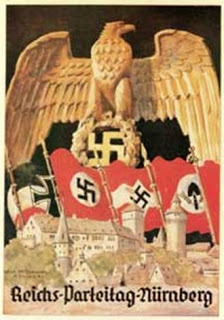
Many have noted the echoes of Purim in the Nuremberg war crime trials. In the Book of Esther, Haman's ten sons were all hanged (Esther 9:13). In 1946, ten of Hitler's top associates were put to death by hanging for their war crimes, including the crime of murdering 6 million Jews. An 11th defendant, Hermann Göring, committed suicide the night before the execution, a parallel to the suicide of Haman's daughter recorded in the Talmud. Göring was rumored to be a transvestite, which makes the parallel even more accurate. One of the defendants seems to have been aware of this. On his way to the gallows, Julius Streicher shouted "Purim Fest 1946."
Another echo of Purim is found in the Soviet Union a few years later. In early 1953, Stalin was planning to deport most of the Jews in the Soviet Union to Siberia, but just before his plans came to fruition, he suffered a stroke and died a few days later. He suffered that stroke on the night of March 1, 1953…the night after Purim. However, because Jewish days end at sunset, calendars that year marked March 1st as Purim. Stalin's plan to deport Jews was never carried out.
A story is told of that 1953 Purim. The Lubavitcher Rabbi led a Purim gathering and was asked to give a blessing for the Jews of the Soviet Union, who were known to be in great danger. Instead, he told a cryptic story about a man who was voting in the Soviet Union and heard people cheering for the candidate, saying, Hoorah! Hoorah! The man did not want to cheer, but was afraid to not cheer, so he said hoorah, but in his heart, he meant it in Hebrew— hu ra, which means, "he is evil." The crowd at the 1953 gathering began chanting "hu ra!" regarding Stalin, and that night, Stalin suffered the stroke that led to his death a few days later.
Next Monday we'll examine the English word Easter.
Until then, we wish you Peace and Blessings.
If you reached this post via a link, click the HOME tab above to see other recent posts and visit our archives.
Published on March 07, 2012 01:00
March 5, 2012
THE THREE MARYS at the EMPTY TOMB
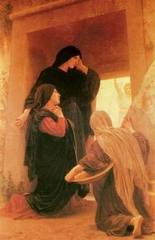
Hello My Friends and Welcome.
The image illustrating this post in our continuing Lenten/Easter series is the painting The Three Mary's at the Empty Tomb by William Adolphe Bouguereau, 1890. Bouguereau's paintings have a softness of color and a sense of serenity about them. We used his 1873 painting, The Newborn Lamb as a cover for Witness, Book One in The Seeds of Christianity™ Series. We went back to Bougereau for Disciple, Book Two of the Series, adapting his 1860 painting, Tobias Saying Goodbye to his Father. Both covers are in the right sidebar.
Now, back to the three Mary's. Which three Mary's is he depicting? The answer, of course, is Mary Magdalene, Mary, the wife of Clopas, and Mary, the wife of Aristopolus. This raises two additional questions: Who are these people and why are they all named Mary?
We all know the first one, Mary from Magdala. She is generally considered to be a woman of means who helped finance Yeshua's ministry. She was also the first to encounter the risen Christ and, mistaking him for a gardener, asked where they had placed the body.
Mary, the wife of Clopas — also Cleopas or Alphaeus — was the wife of Herod Antipas' cup bearer. Cup bearer, by the way, is a polite term for Royal Taster. A rather dicey job when you're serving one of the Herods. Regardless, he was well placed and tradition says both of his sons were publicans, or tax collectors. Most probably they were Mokhes, custom officials. Galilee sat on the main roads of commerce and Herod Antipas' principal source of revenue was derived from the goods passing through his territory. So who were these sons? We know them well. One was named Levi, or Mattithayu (Matthew). His brother's name was Yaakov…Jacob…James. The man we've come to call James the Lesser.
The last Mary, and her husband Aristopolus, were early disciples. They owned the home with the "upper room" where Yeshua and his disciples celebrated the Last Supper. Mary had a brother by the name of Yosef, whom we also know well, as Barnabus the companion of Paul. She also had a son named John Mark…the associate of Peter, author of the Gospel of Mark, and, according to Eusebius, the eventual Bishop of Alexandria.
Why do we find a Mary everywhere time we turn around in the New Testament? The name Mary in all its many permutations, Miriam, Mariam, Maria, Mariamne, Mariamme, Mariamenom, was an extremely popular name in First Century Israel. It's been estimated that somewhere between 25—35% of the women were named some form of Mary. Imagine if these three women attended a dinner at Lazarus' home in Bethany along with Yeshua's mother. Now we have at least five Mary's in the same room…talk about confusion.
I've been asked why I chose to identify Yeshus'a mother as Miryam in my novels. There are two reasons. First, for authenticity I've used the Jewish spelling for the characters and Miryam is the original Jewish form of the name. Secondly, in Biblical manuscripts the name translated as Mary is written as MRYM.
Next time we'll study the Jewish feast of Purim…one that Jesus and his disciples surely celebrated.
Until then, we wish you Peace and Blessings.
If you reached this post via a link, click the HOME tab above to see other recent posts and visit our archives.
Published on March 05, 2012 01:00



